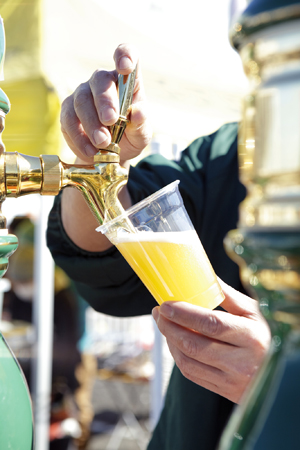
by Kido Hirotaka
Esters, which are the topic of discussion this time, are sometimes referred to as the fermentation bouquet. They are an important part of a beer’s aroma and are described as smelling both fruity and complex. They are present not only in brewed beverages but also distilled ones. In the right amounts, the resulting aromas can resemble pear, peach, pineapple, apple and other similar fruits. In beers that have no actual fruits in them but nevertheless smell fruity, esters are one possible explanation. So let me tell you a little more about them.
First let’s look at which beers esters impart character to. Ales, traditionally made in England, are one. Esters play a particularly important role in the flavor of these beers. Compared to lagers, ales are fermented at higher temperatures. The ale yeast, thus, is more active and produces stronger ester character.
In a traditional German weizen, which uses wheat, esters are rather prominent as well. Many people describe a weizen as banana-like in aroma. Many call the variety of ale yeast used in these beers just “weizen yeast” to make it simple, and this is what creates those aromas. Weizen yeast, much more so than other varieties, is somewhat unique in that it produces rather strong estery and phenolic aromas.
When describing the aromas of a weizen, many say, “Banana and clove esters…” but in reality neither are esters. The clove notes come from phenols, another aromatic component. Sometimes phenols reek of a hospital or a band-aid; other times, they come off as smoky. Next time you have the opportunity to try a weizen, don’t breath in the aroma mix; try to work out the different notes. Esters, put simply, are aromatic compounds created by yeast during fermentation, when the alcohol is produced.
Tasty, well-made beers avoid overly assertive ester aroma and, together with other ingredients and aromatic components, achieve good balance. Esters, however, can sometimes reach high concentrations and smell awful, like paint thinner or medicine, thus ruining a beer. In fact, when the acid and alkali balance goes all out of whack and esters reach extremely high concentrations, then you’ve got a hazardous substance on your hands.
When you drink really bad beer, you may even feel sick. Alcoholic beverages that seem disgusting can cause that not only because of esters, but also because of certain alcohols or other poisonous impurities in high amounts. Your body, essentially saying, “don’t drink that,” is warning you away from headaches and nausea.
Even with delicious, well-balanced beer, though, too much of it can be like poison to your body. So listen up everyone! Drinking too much is bad for you! Pace yourselves and drink appropriately!
This article was published in Japan Beer Times # () and is among the limited content available online. Order your copy through our online shop or download the digital version from the iTunes store to access the full contents of this issue.
